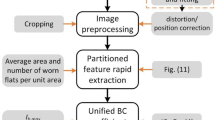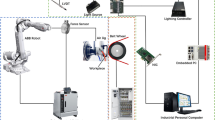Abstract
The wear state of an abrasive belt is one of the important factors affecting the grinding precision of belt grinding processes. At present, there are two problems associated with the monitoring method of the wear condition of abrasive belts: (1) there are no uniform wear criteria to classify the wear condition of abrasive belts, and the segmentation threshold of the wear condition is affected by the change in the grinding parameters; and (2) an abrasive belt wear model based on indirect sensor monitoring of signals is affected by the change in the grinding parameters of abrasive belts; therefore, it is only suitable for abrasive belt wear monitoring under specific grinding parameters. This paper introduces a method of belt wear state monitoring based on machine vision and image processing. Surface images of an abrasive belt during its entire life are captured using a noncontact electron microscope. Three image features related to the wear state are selected: first-order distance of color component R, entropy of the horizontal subgraph, and vertical subgraph of the texture feature. Moreover, the wear state is classified into three categories based on the selected features. Using the selected features and the random forest classification algorithm, an abrasive belt wear state classifier is established. The performance of the classifier is verified and evaluated using a data subset of different images. The results show that the proposed method has high recognition accuracy for belt wear state, which can reach 99% in the accelerated wear stage. The proposed method solves the problem of the dependence and sensitivity of the monitoring model on the variation in the grinding parameters in the process of abrasive belt wear monitoring, and it improves the adaptability and versatility of the monitoring method.




















Similar content being viewed by others
Availability of data and materials
The datasets used or analyzed during the current study are available from the corresponding author on reasonable request.
Change history
02 February 2022
A Correction to this paper has been published: https://doi.org/10.1007/s00170-022-08830-z
References
Xu XH, Chen W, Zhu DH, Yan SJ, Ding H (2021) Hybrid active/passive force control strategy for grinding marks suppression and profile accuracy enhancement in robotic belt grinding of turbine blade. Robot Cim-int Manuf 67:102047
Wang NN, Zhang GP, Pang WJ, Ren LJ, Wang YP (2021) Novel monitoring method for material removal rate considering quantitative wear of abrasive belts based on LightGBM learning algorithm. Int J Adv Manuf Technol 114:3241–3253
Fan WG, Wang WX, Wang JD, Zhang XL, Qian C, Ma TF (2021) Microscopic contact pressure and material removal modeling in rail grinding using abrasive belt. P I Mech Eng B-J Eng 235(1–2):3–12
Huang Y, He S, Xiao GJ, Li W, Jiahua SL, Wang WX (2020) Effects research on theoretical-modelling based suppression of the contact flutter in blisk belt grinding. J Manuf Process 54:309–317
Lv YJ, Peng Z, Qu C, Zhu DH (2020) An adaptive trajectory planning algorithm for robotic belt grinding of blade leading and trailing edges based on material removal profile model. Robot Cim-int Manuf 6:101978
Pandiyan V, Tjahjowidodod T (2019) Use of acoustic emissions to detect change in contact mechanisms caused by tool wear in abrasive belt grinding process. Wear 436–437:203047
Pandiyan V, Shevchik S, Wasmer K, Castagnec s., Tjahjowidodod T. (2020) Modelling and monitoring of abrasive finishing processes using artificial intelligence techniques: a review. J Manuf Process 57:114–135
Cheng C, Li JY, Liu YM, Nie M, Wang WX (2020) An online belt wear monitoring method for abrasive belt grinding under varying grinding parameters. J Manuf Process 50:80–89
Qi JD, Chen B, Zhang DH (2020) Multi-information fusion-based belt condition monitoring in grinding process using the improved-Mahalanobis distance and convolutional neural networks. J Manuf Process 59:302–315
Oo H, Wang W, Liu ZH (2020) Tool wear monitoring system in belt grinding based on image-processing techniques. Int J Adv Manuf Technol 170(2):6254
Pandiyan V, Caesarendra W, Tjahjowidodo T, Tan HH (2018) In-process tool condition monitoring in compliant abrasive belt grinding process using support vector machine and genetic algorithm. J Manuf Process 31:199–213
Zhang XQ, Chen HB, Xu JJ, Song XF, Wang JW, Chen XQ (2018) A novel sound-based belt condition monitoring method for robotic grinding using optimally pruned extreme learning machine. J Mater Process Tech 260:9–19
Chen JQ, Chen HB, Xu JJ, Wang JW, Zhang XQ, Chen XQ (2018) Acoustic signal-based tool condition monitoring in belt grinding of nickel-based superalloys using RF classifier and MLR algorithm. Int J Adv Manuf Technol 98:859–872
Kwak JS, Ha MK (2004) Detection of dressing time using the grinding force signal based on the discrete wavelet decomposition. Int J Adv Manuf Technol 23(1–2):87–92
Wang W, Salvatore F, Rech J, Li JY (2018) Comprehensive investigation on mechanisms of dry belt grinding on AISI52100 hardened steel. Tribol Int 121:310–320
Khellouki A, Rech J, Zahouani H (2007) The effect of abrasive grain’s wear and contact conditions on surface texture in belt finishing.Wear 263(1):81–87
Cheng C, Li JY, Liu YM, Nie M, Wang WX (2019) Deep convolutional neural network-based in-process tool condition monitoring in abrasive belt grinding. Comput Ind 106:1–13
Segu D. Z, Wang LL, Hwang P, Kang SW (2021) Experimental characterization of friction and wear behavior of textured titanium alloy (Ti-6Al-4V) for enhanced tribological performance. Mater Res Express, 8(8):085008
Amir MT, Zhao HL, Henri C, Bruce H, Marin L (2015) Characterization of grinding wheel grain topography under different robotic grinding conditions using confocal microscope. Int J Adv Manuf Technol 80(5–8):1159–1171
Feng Z, Chen X (2007) Image processing of grinding wheel surface. Int J Adv Manuf Technol 32:27–33
Arunachalam N, Ramamoorthy B (2007) Texture analysis for grinding wheel wear assessment using machine vision. P I Mech Eng B-J Eng 221(3):419–430
Stéphane L, Bauer R, Warkentin A (2004) Application of region growing method to evaluate the surface condition of grinding wheels. Int J Mach Tools Manuf 44(7–8):823–829
Amarjit PK, Sounak KC (2019) Analytical modeling of tool health monitoring system using multiple sensor data fusion approach in hard machining. Measurement 145:118–129
Wang JC, Zou B, Liu MF, Li YS, Ding HJ, Xue K (2021) Milling force prediction model based on transfer learning and neural network. J Intell Manuf 32:947–956
Kuntoglu M, Saglam H (2021) Investigation of signal behaviors for sensor fusion with tool condition monitoring system in turning. Measurement 173:108582
Huang ZW, Zhu JM, Lei JT, Li XR, Tian FQ (2019) Tool wear predicting based on multi-domain feature fusion by deep convolutional neural network in milling operations. J Intell Manuf 31(4):953–966
Xu XW, Tao ZR, Ming WW, An QL, Chen M (2020) Intelligent monitoring and diagnostics using a novel integrated model based on deep learning and multi-sensor feature fusion. Measurement 165:108086
Zhou YQ, Sun BT, Sun WF, Lei Z (2020) Tool wear condition monitoring based on a two-layer angle kernel extreme learning machine using sound sensor for milling process. J Intell Manuf. https://doi.org/10.1007/s10845-020-01663-1
Dong X, Li GL, Jia YC, Xu K (2021) Multiscale feature extraction from the perspective of graph for hob fault diagnosis using spectral graph wavelet transform combined with improved random forest. Measurment 176:109178
Madana Mohana R, Kishor Kumar Reddy C, Anish PR, Ramana Murthy BV (2021) Random forest algorithms for the classification of tree-based ensemble. Materials Today: Proceedings. https://doi.org/10.1016/j.matpr.2021.01.788
Funding
This work was supported by the Shaanxi Province key projects (grant number 2017ZDXM-GY-133).
Author information
Authors and Affiliations
Contributions
Nina Wang performed the analysis and summary of the experimental data and was a major contributor in writing the manuscript. Lijuan Ren, Nina Wang, and Wanjing Pang participate in carrying out grinding experiments. All authors read and approved the final manuscript.
Corresponding author
Ethics declarations
Ethics approval
All data in this paper comes from machining grinding experiments and does not involve ethical issues.
Consent to participate
Not applicable.
Consent for publication
Not applicable.
Conflict of interest
The authors declare no competing interests.
Additional information
Publisher's Note
Springer Nature remains neutral with regard to jurisdictional claims in published maps and institutional affiliations.
The original online version of this article was revised: Figures 1 and 2 has been updated.
This article is part of the Topical Collection: New Intelligent Manufacturing Technologies through the Integration of Industry 4.0 and Advanced Manufacturing
Rights and permissions
About this article
Cite this article
Wang, N., Zhang, G., Ren, L. et al. Novel monitoring method for belt wear state based on machine vision and image processing under grinding parameter variation. Int J Adv Manuf Technol 122, 87–101 (2022). https://doi.org/10.1007/s00170-021-08393-5
Received:
Accepted:
Published:
Issue Date:
DOI: https://doi.org/10.1007/s00170-021-08393-5




